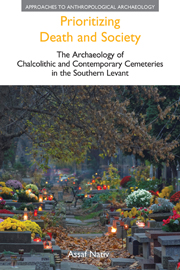 Prioritizing Death and Society
Prioritizing Death and Society from Part II - Chalcolithic cemeteries
The four preceding chapters offered a fairly detailed survey of four types of cemeteries used during the Chalcolithic period of the southern Levant. Together they account for the great majority of known cases and offer an answer to the confusing variability that has hindered the crystallization of a deeper understanding of these phenomena. Yet, every rule has its exceptions; every perceived order has its incompatibilities. And, indeed, alongside the many cemeteries that are readily assigned to one category or another, one cannot escape noting several that do not fit, either because they defy an elemental principle that characterizes other cemeteries in their vicinity, or because they seem to present a class that is unprecedented altogether.
No account of Chalcolithic cemeteries is complete without acknowledging these cases. It is thus the aim of this chapter to present these cases and offer as good an account of their peculiarity/singularity as possible. Each of these will be discussed separately and their qualities compared to the now hopefully better-established categories. However, the degree of success varies and depends upon the extent to which the variations can be attributed to structural features or contingent circumstances. Their order of presentation will progress roughly from north to south.
Sha'ar Efrayim
The cemetery of Sha'ar Efrayim is located in the Sharon Valley, east of the eponymous modern community.
To save this book to your Kindle, first ensure [email protected] is added to your Approved Personal Document E-mail List under your Personal Document Settings on the Manage Your Content and Devices page of your Amazon account. Then enter the ‘name’ part of your Kindle email address below. Find out more about saving to your Kindle.
Note you can select to save to either the @free.kindle.com or @kindle.com variations. ‘@free.kindle.com’ emails are free but can only be saved to your device when it is connected to wi-fi. ‘@kindle.com’ emails can be delivered even when you are not connected to wi-fi, but note that service fees apply.
Find out more about the Kindle Personal Document Service.
To save content items to your account, please confirm that you agree to abide by our usage policies. If this is the first time you use this feature, you will be asked to authorise Cambridge Core to connect with your account. Find out more about saving content to Dropbox.
To save content items to your account, please confirm that you agree to abide by our usage policies. If this is the first time you use this feature, you will be asked to authorise Cambridge Core to connect with your account. Find out more about saving content to Google Drive.